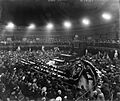History of the Labour Party (Ireland) facts for kids
The Labour Party is one of Ireland's oldest political parties. It has been involved in Irish politics since the country became independent. While it has never been the biggest party, it has often joined with other parties to form governments.
Contents
The Labour Party: A Look Back
The Labour Party was started in 1912. Key figures like James Connolly, James Larkin, and William O'Brien helped create it. It began as the political part of the Irish Trades Union Congress. The party hoped to be part of a new Irish parliament. This parliament was planned after the Home Rule Act of 1914. However, World War I stopped these plans.
Early Challenges and Growth
After the Easter Rising in 1916, James Connolly was executed. Thomas Johnson then became the leader. The party did not take part in the 1918 and 1921 elections. Despite some disagreements, Labour won about 20% of the votes in the 1922 elections. It became the main opposition party in the Dáil Éireann (parliament) of the Irish Free State.
Many farm workers joined the party. This helped the Irish trade union movement grow after World War I. For a long time, many Labour politicians were independent thinkers. They were supported by agricultural workers. The party was first called the Irish Labour Party and Trades Union Congress. In 1930, the trade union and the political party officially separated.
Leaders and Coalitions
The years after 1930 saw some disagreements within the party. William O'Brien and James Larkin led different groups. William Norton later became the leader. From 1932 to 1938, the Labour Party supported Éamon de Valera's Fianna Fáil government.
Between 1948 and 1951, and again from 1954 to 1957, Labour joined governments. They worked with Fine Gael and other parties. During these times, William Norton served as Tánaiste (Deputy Prime Minister). Labour also ran in elections in Northern Ireland for a while.
In 1960, Brendan Corish became the new Labour leader. He brought more socialist ideas to the party. From 1973 to 1987, Labour joined coalition governments with Fine Gael three more times. Dick Spring became leader in 1982.
Modern Era and Recent Events
In 1990, Mary Robinson became President of Ireland with Labour's support. This was a big moment for the party. Labour also merged with the Democratic Socialist Party and the Independent Socialist Party.
In the 1992 election, Labour did very well. They formed a government with Fianna Fáil, with Dick Spring as Tánaiste. Then, in 1994, they joined a new government. This "Rainbow Coalition" included Fine Gael and Democratic Left.
After losing the 1997 election, Labour merged with Democratic Left. Pat Rabbitte became leader in 2002. He tried a voting agreement with Fine Gael. However, this did not lead to more success in the 2007 elections. Rabbitte then resigned. Eamon Gilmore took over as leader.
The 2011 election was one of Labour's best results. They got over 19% of the votes. Labour again joined a government with Fine Gael. Later that year, Labour's candidate, Michael D. Higgins, was elected President of Ireland. However, Labour faced some challenges while in government. In 2014, Eamon Gilmore resigned as leader. This happened after the party did not do well in European and local elections. Joan Burton was then elected as the new leader.
What the Labour Party Believes In
The Labour Party is generally seen as a "centre-left" party. This means they believe in social fairness and helping people. They are often called a social democratic party. Their own rules describe them as a "movement of democratic socialists, social democrats, environmentalists, progressives, feminists (and) trade unionists." Some people call it a "big tent" party. This means it includes many different types of people and ideas.
Changing Ideas Over Time
The Labour Party's beliefs have changed a lot over the years. In the past, some described Labour as a "cautious" and "rural" party. This was surprising given its start in trade unions. One historian even called it "the most opportunistically conservative Labour Party" because of its strong Catholic views. At that time, most people in Ireland were Catholic. The party, like others, was slow to support ideas that seemed against Catholic teachings.
However, from the 1980s, Labour started to support more socially liberal policies. This included things like divorce and LGBT+ rights. Former leader Eamon Gilmore said in 2007 that Labour helped "modernise the Irish state."
The party's traditional symbol is the 'Starry Plough.' This symbol has roots in Christian and biblical ideas. In the past, Labour also supported "corporatist" policies. This meant working closely with different groups in society, influenced by the Catholic Church. This was seen as a way to gain support from working and middle-class people.
More recently, Labour has become known for supporting secularism. This means separating religion from government. They have also championed socially liberal causes. Their supporters have also shifted towards valuing things like self-expression and quality of life more. The Labour Party also changed its view on Europe. In 1972, they were against joining the European Economic Community. Now, they are strongly pro-European and work with other social-democratic parties in Europe.
Images for kids
-
In 1938, the renowned Irish nationalist and suffragist, Maud Gonne MacBride, endorsed Labour's Social Outlook, a revamped party policy document created by former Cork TD, Timothy Quill.
-
Mary Robinson's victory in the 1990 Presidential election was considered a breakthrough moment for Labour
-
Politicians Pat Rabbitte, Michael D Higgins and Derek Nolan of the Irish Labour Party in 2010
See also
- Labour Party (Ireland)
- Category:Labour Party (Ireland) politicians









